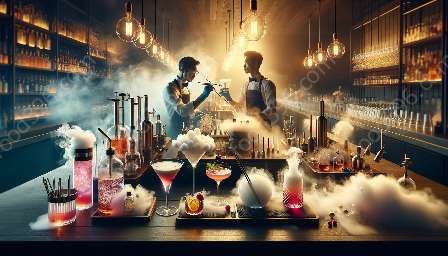Opening a new chapter in mixology, foam stability and texture manipulation techniques have revolutionized the way we experience and enjoy cocktails. This article will explore the art and science of creating and utilizing foams, spherification techniques, and molecular mixology to create unique textures and flavors.
The Art of Foam Stability
Foam stability is a crucial aspect of mixology that involves creating stable foam textures to enhance the visual appeal, aroma, and mouthfeel of a cocktail. The stability of foam in mixology is achieved through various methods such as using foaming agents, emulsifiers, and stabilizers.
Foaming Agents
One of the key elements in creating stable foam in mixology is the use of foaming agents. Foaming agents are substances that help to form and stabilize foam structures. Common foaming agents used in mixology include egg whites, aquafaba, and gelatin, each contributing to unique textures and stability.
Emulsifiers and Stabilizers
To further enhance foam stability, mixologists often incorporate emulsifiers and stabilizers into their cocktail recipes. Emulsifiers, such as lecithin, help to create stable emulsions, while stabilizers like agar-agar and xanthan gum contribute to the overall stability and texture of the foam.
Texture Manipulation and Spherification Techniques
Texture manipulation in mixology extends beyond foam stability and encompasses techniques such as spherification, which involves creating spheres of liquid with a thin gel membrane. Spherification adds an innovative and intriguing dimension to cocktails, allowing mixologists to infuse unique flavors and textures into their creations.
Basic Spherification
In basic spherification, mixologists use sodium alginate and calcium salts to form a gel membrane on the exterior of liquid droplets, resulting in flavorful and visually captivating spheres. This technique opens up endless possibilities for mixologists to experiment with different flavor combinations and presentations.
Reverse Spherification
Another spherification technique, known as reverse spherification, involves submerging a flavorful liquid in a calcium salt solution, allowing a gel membrane to form whilst the interior remains liquid. This method is particularly suitable for creating cocktail garnishes and additions with a burst of flavor.
Molecular Mixology and Foam Creation
Molecular mixology encompasses the use of scientific principles and techniques to create innovative and unconventional cocktails. Foam stability and texture manipulation play a significant role in molecular mixology, allowing mixologists to push the boundaries of traditional cocktail making and explore new realms of creativity.
Aroma and Visual Appeal
By utilizing foam stability and spherification techniques, mixologists can enhance the aroma and visual appeal of their cocktails, providing a multi-sensory experience for patrons. The delicate textures and captivating presentations elevate the overall enjoyment of the cocktail, making it a memorable and immersive experience.
Flavor Infusion and Complexity
Through texture manipulation and spherification, mixologists can infuse complex flavors into their cocktails, introducing layers of taste and texture that captivate the palate. Molecular mixology empowers mixologists to experiment with unconventional ingredients and techniques, resulting in unique and delectable concoctions.
Conclusion
The world of mixology continues to evolve, and foam stability, texture manipulation, and molecular mixology have paved the way for unprecedented creativity and innovation. By understanding the science behind foam stability, spherification techniques, and molecular mixology, mixologists can elevate their craft and delight patrons with captivating textures and flavors.

